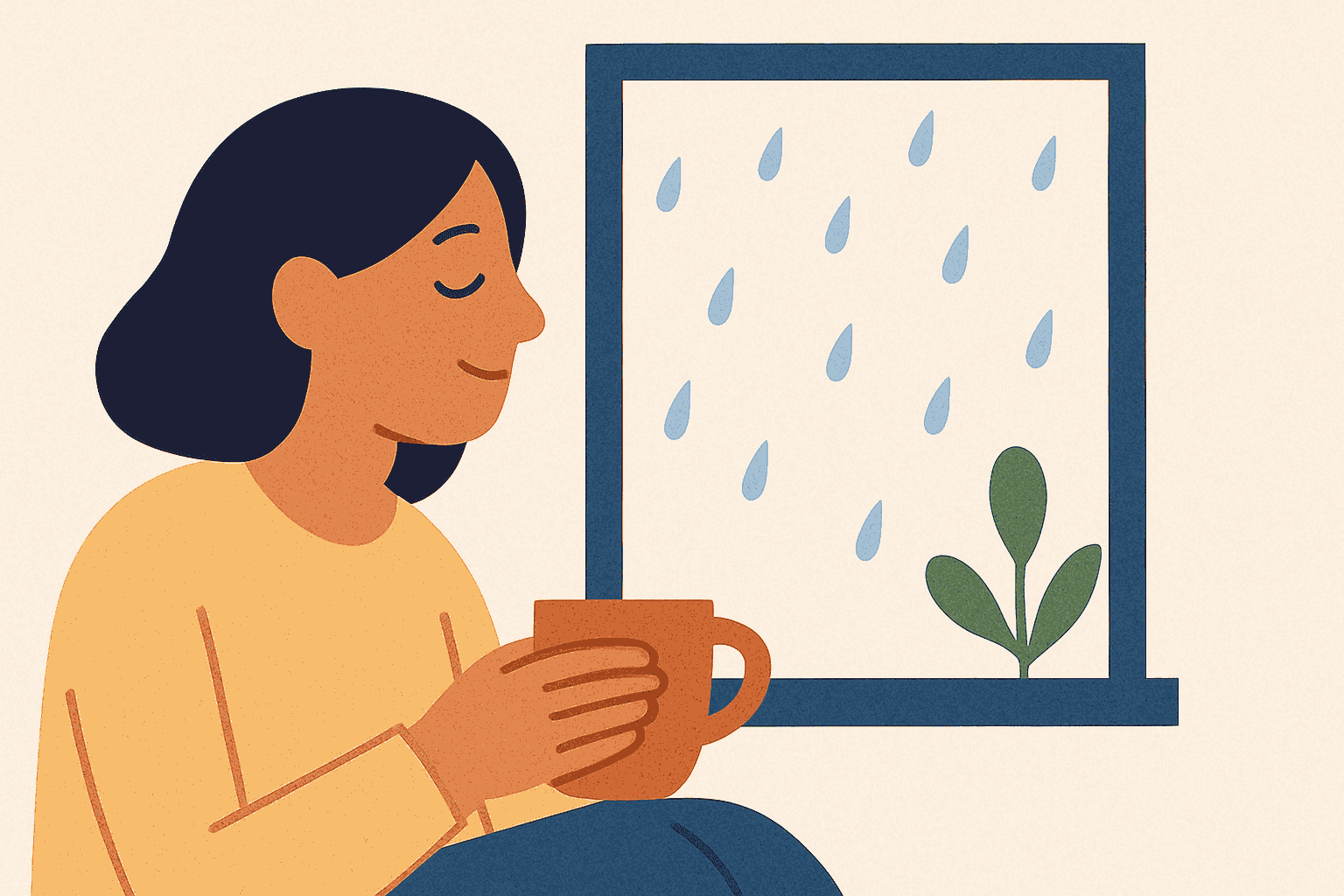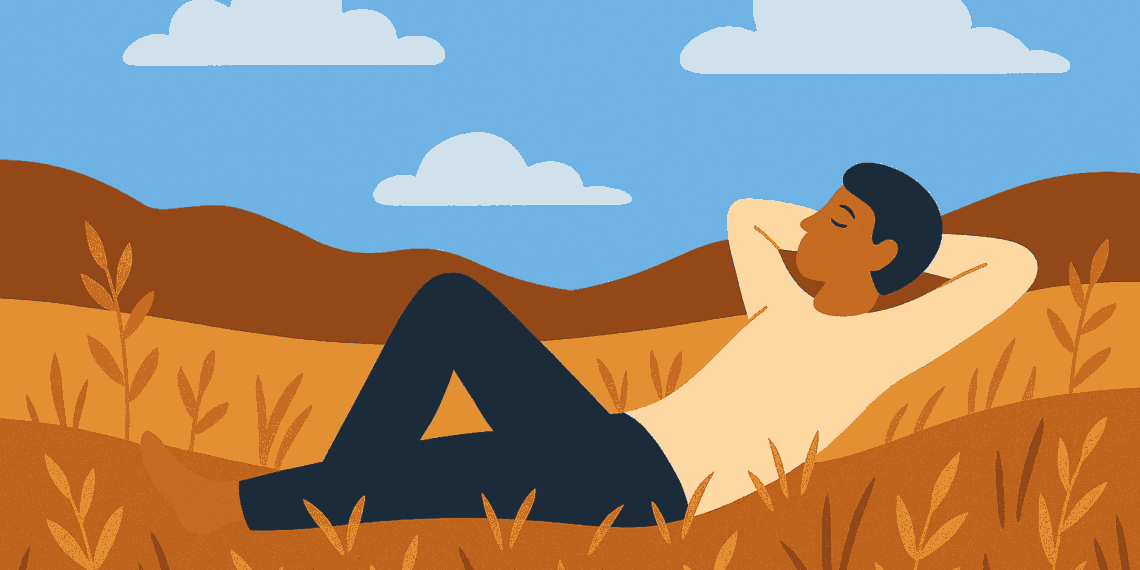The Art of Doing Nothing is more than a pause, it’s a vital skill we all need in today’s overstimulated world.
We live in a world that rewards busyness and labels stillness as laziness. But the truth is, doing nothing is not just a break from productivity, it’s a radical act of self-reconnection.
Also read: What Are Emotional Needs and How to Meet Them
Contents
- 1 🌿 What Does “Doing Nothing” Actually Mean?
- 2 😶🌫️ Why Do We Struggle With It?
- 3 🌬 Why Doing Nothing is Deeply Important
- 4 🌱 How to Practice the Art of Doing Nothing
- 5 🍂 Ideas for “Doing Nothing” Rituals
- 6 📝 After Doing Nothing: Gentle Journal Prompts
- 7 🌻 Real-Life Benefits People Report
- 8 💡 Doing Nothing vs Escaping
- 9 🌌 Philosophies That Honour Stillness
- 10 🕊️ Final thoughts: Stillness is Not Empty
🌿 What Does “Doing Nothing” Actually Mean?

The art of doing nothing is not laziness, it’s a conscious skill that can help us reclaim balance in our lives. At first glance, “doing nothing” seems like the absence of action. But if you look deeper, it’s a presence without pressure. It’s the act of sitting with yourself without distractions, roles, or obligations. You’re not scrolling, performing, fixing, or planning. You’re simply being. Fully. Freely.
It’s:
- Sitting by the window, watching the sunlight change.
- Lying on the floor, listening to the fan hum above.
- Drinking chai without also checking emails or talking.
- Watching the rain drip slowly from a leaf, doing absolutely nothing else.
It sounds simple, but for many of us, it’s unfamiliar—even terrifying.
😶🌫️ Why Do We Struggle With It?
1. Hustle Conditioning
From a young age, we’re taught that success equals action. If you’re not moving, you’re falling behind. The idea of doing nothing clashes with this conditioning, so it triggers guilt.
2. Fear of Meeting Ourselves
When the noise stops, we meet our truth. Unprocessed emotions, memories, and unmet needs rise to the surface. That’s uncomfortable. So we escape through scrolling, working, or overthinking.
3. Addiction to Stimulation
We’re dopamine-driven creatures. Social media, texts, music, notifications—they give us micro-rewards constantly. In comparison, stillness feels dull. But it’s actually where the nervous system repairs itself.
4. Cultural Shame Around Rest
Especially in high-pressure environments, rest is seen as weakness. We associate doing nothing with laziness, instead of intelligence and intentional recovery.
🌬 Why Doing Nothing is Deeply Important
Learning the art of doing nothing may be one of the most productive things we can do for our mental health. Doing nothing may seem passive, but it activates powerful internal processes that are impossible during over-stimulation. Here’s why it matters:
🧠 1. Boosts Creativity
Our most brilliant ideas come when the mind is relaxed. Ever noticed how your best insights happen while showering or walking aimlessly? That’s because when the conscious mind stops pushing, the subconscious begins to speak.
💗 2. Rebuilds Emotional Balance
We can’t hear what we feel when we’re always distracted. Stillness lets us actually listen to the emotions under our anxiety or fatigue. It creates emotional clarity.
🌀 3. Heals Decision Fatigue
Every day, we make hundreds of micro-decisions. This drains mental energy. Doing nothing helps reset the mind, allowing better choices with less internal chaos.
🪞 4. Increases Self-Awareness
When you’re not chasing noise, you finally meet your inner landscape. Stillness reveals what you’re actually thinking, fearing, or longing for, without distractions.
🌸 5. Builds Nervous System Resilience
Physiologically, resting in non-stimulation activates the parasympathetic nervous system (the rest-digest-heal state), reducing cortisol and improving digestion, immunity, and even hormone balance.
⌛ 6. Makes Time Feel Fuller
Busy days blur by. But doing nothing—real, intentional nothing—expands your sense of time. You start living in minutes instead of sprinting through hours.
🌱 How to Practice the Art of Doing Nothing
Many of us have forgotten that the art of doing nothing is a valuable tool for emotional reset. Start with these simple, soul-friendly steps. You don’t need a retreat or fancy setup. Just willingness.
✨ 1. Choose a Space
Pick a space where you feel mentally safe. It could be your bed, a balcony, your floor, or a corner by a plant. Somewhere quiet enough to breathe.
✨ 2. Set a Gentle Time Limit
Start with 5 to 10 minutes. You’re not meditating or trying to achieve anything. Just being. No phone. No goal.
✨ 3. Let Go of “Results”
The point isn’t to feel peaceful or gain insight. Let it be awkward or boring. Let your mind wander. Just observe without interference.
✨ 4. Engage the Senses
What do you hear, feel, or smell right now? This anchors your attention in the now without effort. You can watch light patterns on the wall or the rhythm of your breath.
✨ 5. Resist the Urge to Distract
Notice the moment your hand wants to reach for your phone or your brain wants to problem-solve. Gently come back to nothing.
🍂 Ideas for “Doing Nothing” Rituals

- Sit with a cup of warm water or tea and do nothing else.
- Lie down and follow your breath with no intention to control it.
- Sit on the floor and look out the window—no music, no reading.
- Watch a tree or plant move in the breeze.
- Light a candle and stare into the flame.
- Walk slowly in your room, barefoot, noticing the ground under your feet.
📝 After Doing Nothing: Gentle Journal Prompts
If you’d like to reflect afterward, here are prompts that won’t overwhelm:
- What came up during my stillness?
- Did I feel peace, restlessness, or something unexpected?
- What am I running from when I stay constantly busy?
- How did my body feel during stillness?
- What did I not want to think about, and why?
🌻 Real-Life Benefits People Report
Many who integrate intentional stillness into their day report:
- Deeper sleep and fewer anxious dreams.
- Less irritability or overwhelm.
- More emotional clarity, especially in relationships.
- Unexpected ideas or solutions.
- A softer heart and stronger boundaries.
💡 Doing Nothing vs Escaping
Important distinction: Doing nothing is not the same as numbing.
Scrolling reels, binge-watching, or constant talking may look like relaxing, but they stimulate rather than restore. True stillness is without noise. It’s the absence of input. And that’s where the healing begins. Ultimately, the art of doing nothing teaches us to slow down, observe, and simply be, without guilt.
🌌 Philosophies That Honour Stillness
Almost every ancient wisdom system emphasizes stillness:
- Taoism teaches the value of “wu wei” — effortless action or aligned inaction.
- Indian philosophy celebrates “mauna” (sacred silence) as a state of truth.
- Zen Buddhism uses “zazen” (just sitting) to train awareness in pure being.
- Stoicism valued solitude and deep inner reflection to access clarity and strength.
Stillness has always been the doorway to insight, intuition, and peace.
🕊️ Final thoughts: Stillness is Not Empty
In stillness, the world begins to breathe again.
When we slow down, life catches up.
Doing nothing doesn’t make you fall behind—it brings you back to yourself.
Let yourself be. Let yourself pause. Let silence soften you. Because in a loud world that always demands more, the rarest, most beautiful rebellion is to exist without effort.
By embracing the art of doing nothing, we allow ourselves to breathe, reflect, and reconnect with what truly matters.
Sources: BBC, Psychology Today, Moreno Zugaro‘s Medium.

